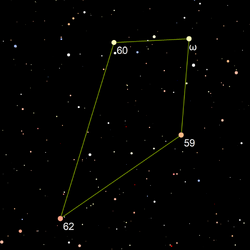Astronomy:59 Sagittarii
| Observation data Equinox J2000.0]] (ICRS) | |
|---|---|
| Constellation | Sagittarius |
| Right ascension | 19h 56m 56.83165s[1] |
| Declination | −27° 10′ 11.6409″[1] |
| Apparent magnitude (V) | 4.54[2] |
| Characteristics | |
| Spectral type | K2.5IIb[3] |
| U−B color index | +1.462±0.048[2] |
| B−V color index | +1.46[4] |
| R−I color index | +0.73[4] |
| Astrometry | |
| Radial velocity (Rv) | −16.4±0.9[2] km/s |
| Proper motion (μ) | RA: +10.46[1] mas/yr Dec.: −15.52[1] mas/yr |
| Parallax (π) | 3.92 ± 0.28[1] mas |
| Distance | 830 ± 60 ly (260 ± 20 pc) |
| Absolute magnitude (MV) | −2.48[2] |
| Details | |
| Mass | 6.2±0.1[5] M☉ |
| Radius | 100.19+4.73 −6.60[6] R☉ |
| Luminosity | 2,825±287[6] L☉ |
| Surface gravity (log g) | 1.78[7] cgs |
| Temperature | 4,204+146 −96[6] K |
| Metallicity [Fe/H] | −0.10±0.06[2] dex |
| Age | 64.2±17.7[5] Myr |
| Other designations | |
| Database references | |
| SIMBAD | data |
59 Sagittarii is a single[9] star in the southern constellation of Sagittarius,[8] about a degree to the south of Omega Sagittarii near the constellation border with Capricornus. It has the Bayer designation b Sagittarii, or sometimes b1 Sagittarii,[10] while 59 Sagittarii is the Flamsteed designation. The star is visible to the naked eye as a faint, orange-hued star with an apparent visual magnitude of 4.544. It forms the southeast corner of the asterism called the Terebellum. Based upon parallax measurements, the star is located approximately 830 light years away from the Sun.[1] It is moving closer to the Earth with a heliocentric radial velocity of −16 km/s.[2]
This is an aging bright giant star with a stellar classification of K2.5IIb,[3] having exhausted the supply of hydrogen at its core and expanded to 100[6] times the radius of the Sun. It is 64[5] million years old with 6.2[5] times the Sun's mass. The star is radiating 2,825[6] times the luminosity of the Sun from its swollen photosphere at an effective temperature of 4,204 K.[6]
References
- ↑ 1.0 1.1 1.2 1.3 1.4 1.5 Van Leeuwen, F. (2007). "Validation of the new Hipparcos reduction". Astronomy and Astrophysics 474 (2): 653–664. doi:10.1051/0004-6361:20078357. Bibcode: 2007A&A...474..653V.
- ↑ 2.0 2.1 2.2 2.3 2.4 2.5 Anderson, E.; Francis, Ch. (2012). "XHIP: An extended hipparcos compilation". Astronomy Letters 38 (5): 331. doi:10.1134/S1063773712050015. Bibcode: 2012AstL...38..331A.
- ↑ 3.0 3.1 Keenan, Philip C.; McNeil, Raymond C. (1989). "The Perkins catalog of revised MK types for the cooler stars". Astrophysical Journal Supplement Series 71: 245. doi:10.1086/191373. Bibcode: 1989ApJS...71..245K.
- ↑ 4.0 4.1 Hoffleit, D.; Warren, Jr., W. H.. "HR 7604, database entry, The Bright Star Catalogue". CDS. http://webviz.u-strasbg.fr/viz-bin/VizieR-5?-out.add=.&-source=V/50/catalog&recno=7604. V/50.
- ↑ 5.0 5.1 5.2 5.3 Tetzlaff, N. et al. (January 2011). "A catalogue of young runaway Hipparcos stars within 3 kpc from the Sun". Monthly Notices of the Royal Astronomical Society 410 (1): 190–200. doi:10.1111/j.1365-2966.2010.17434.x. Bibcode: 2011MNRAS.410..190T.
- ↑ 6.0 6.1 6.2 6.3 6.4 6.5 Brown, A. G. A. (August 2018). "Gaia Data Release 2: Summary of the contents and survey properties". Astronomy & Astrophysics 616: A1. doi:10.1051/0004-6361/201833051. Bibcode: 2018A&A...616A...1G. Gaia DR2 record for this source at VizieR.
- ↑ McWilliam, Andrew (December 1990), "High-resolution spectroscopic survey of 671 GK giants. I - Stellar atmosphere parameters and abundances", Astrophysical Journal Supplement Series 74: 1075–1128, doi:10.1086/191527, Bibcode: 1990ApJS...74.1075M
- ↑ 8.0 8.1 "b Sgr". SIMBAD. Centre de données astronomiques de Strasbourg. http://simbad.u-strasbg.fr/simbad/sim-basic?Ident=b+Sgr.
- ↑ Eggleton, P. P.; Tokovinin, A. A. (September 2008). "A catalogue of multiplicity among bright stellar systems". Monthly Notices of the Royal Astronomical Society 389 (2): 869–879. doi:10.1111/j.1365-2966.2008.13596.x. Bibcode: 2008MNRAS.389..869E.
- ↑ Kostjuk, N. D. (2002). "HD 188603, database record, HD-DM-GC-HR-HIP-Bayer-Flamsteed Cross Index". Institute of Astronomy of Russian Academy of Sciences. http://vizier.u-strasbg.fr/viz-bin/VizieR-5?-out.add=.&-source=IV/27/catalog&recno=3042. CDS ID IV/27
 |


